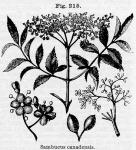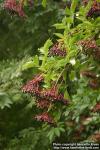
 Preparations: Elder-Flower Water
- Wine of Elder
Preparations: Elder-Flower Water
- Wine of Elder
"The flowers of Sambucus canadensis, Linné"—(U. S. P.). In Eclectic medicine, the fresh inner bark is preferred.
Nat. Ord.—Caprifoliaceae.
COMMON NAMES: Elder, American elder.
ILLUSTRATION: Bentley and Trimen, Med. Plants, 138.
Botanical Source.—Sambucus canadensis is a common, well-known native plant, from 5 to 12 feet high, with a shrubby stem, filled with a light and porous pith, especially when young. The bark is rather scabrous and cinerous. The leaves are nearly bipinnate, and antiposed; leaflets in 3 or 4 pairs with an odd one, oblong, oval, acuminate, smooth, serrate, with the lower ones often 2 or 3-parted. Petioles smooth. Flowers numerous, white, in very large, level-topped, 5-parted cymes, and have a heavy odor. Calyx small and 5-parted; corolla 5-cleft, with segments obtuse; stamens 5; stigma obtuse, small, and sessile. The fruit consists of numerous purplish-black berries (W.).
History.—Sambucus canadensis is an indigenous shrub, growing in all parts of the United States, in low, damp grounds, thickets, and waste places, flowering in June and July, and maturing its berries in September and October. S. nigra (see Related Species) is indigenous to Europe, growing in situations similar to those of the American variety. The two plants possess similar medicinal properties. The medicinal parts are the flowers, the berries, and the inner bark.
Description and Chemical Composition.—The U. S. P. recognizes the flowers only, giving the following description: "The flowers, when fresh, about 5 Mm. (⅕ inch) broad, and, after drying, shrivelled; calyx superior, minutely 5-toothed; corolla originally cream-colored, after drying pale brownish -yellow, wheel-shaped and 5-lobed, with 5 stamens on the short tube; odor peculiar; taste sweetish, somewhat aromatic and bitterish. The peduncles and pedicels of the inflorescence should be rejected"—(U. S. P.). The odor of the flowers is characteristic and heavy, quite powerful when fresh, but faint when dried; they are slightly aromatic and bitterish, and impart their virtues to hot water. Boiling dissipates a volatile oil, which may be obtained by distillation with water; when cold it has the consistence of butter. Mr. F. F. Lyons (Amer. Jour. Pharm., 1892, p. 1) found the bitterness of the flowers to be due to an amorphous, yellow, glucosidal substance, soluble in chloroform. The berries have little or no odor, an acid-saccharine taste, and yield by expression a purple juice, called elder-rob, which turns a dark-lilac color with alkalies, and a scarlet with acids; acetate of lead added to the juice causes a blue deposit of its coloring substance. It contains malic acid, some citric acid, and, according to J. B. Metzger (Amer. Jour. Pharm., 1881, p. 553), a dark-brown resin, fat, sugar, gum, tannin, etc. The inner bark is whitish, with a green tint, odorless, of a saccharine taste, but subsequently bitterish, with some acrimony, and imparts its properties to water or alcohol. Mr. Charles G. Traub (Amer. Jour. Pharm., 1881, p. 392) found the bark to contain valerianic acid, volatile oil, fat, resin, tannin, sugar, coloring matter, etc. Also see quantitative analysis, by C. Otto Moosbrugger (ibid., 1895, p. 520), who found tannin, starch, alkaloids, and glucosids to be absent.
Action, Medical Uses, and Dosage.—Sambucus is stimulant to all of the emunctories, increasing secretion. In warm infusion, elder flowers are diaphoretic and gently stimulant; in cold infusion, they are diuretic, alterative, and cooling, and may be used in all diseases requiring such action, as in hepatic derangements of children, erysipelas, erysipelatous diseases, etc. In infusion, with maidenhair and beech-drops, they will be found very valuable in all erysipelatous diseases. The expressed juice of the berries, evaporated to the consistence of a syrup, is a valuable aperient and alterative; 1 ounce of it will purge. An infusion of the young leaf-buds is likewise purgative, and sometimes acts with violence. The flowers and expressed juice of the berries have been beneficially employed in scrofula, cutaneous diseases, syphilis, rheumatism, etc. The inner green bark is cathartic; an infusion of it in wine or cider, or the expressed juice, will purge moderately, in doses of from ½ to 1 fluid ounce; large doses produce emesis; in small ones, it proves an efficient deobstruent, promoting all the fluid secretions, and is much used in dropsy, especially that following scarlatina, and other febrile and exanthematous diseases, as well as in many chronic diseases. Specific Sambucus is largely used as an alterative where there is a tendency to unhealthy deposits in, or depravation of the tissues. The chief indication for sambucus is a fullness or oedematous condition of the parts, giving them a watery and flabby appearance. In these conditions it is a valuable agent in dropsy. Webster asserts that small doses of specific sambucus are valuable in the catarrhal nasal obstructions of infants. The juice of the root in 1 ounce doses, daily, acts as a hydragogue cathartic and diuretic, and will be found valuable in dropsical affections requiring purgation.
Externally, sambucus is a valuable agent, especially for eruptions which appear upon the full, flabby, oedematous tissues as described above, and particularly when attended with abundant discharge of serum. Beaten up with lard or cream, it forms an excellent discutient ointment, which is of much value in burns, scalds, and some cutaneous diseases, such as eczema, milk-scall, old ulcers, with soft, oedematous edges and free secretion of serum, and in mucous patches, with free discharges. The dose of specific sambucus ranges from 1 to 60 drops; decoction (inner bark, 2 ounces, to water, 1 quart, boiled down to 1 pint), from 2 to 4 fluid ounces.
Specific Indications and Uses.—In skin affections, when the tissues are full, flabby, and oedematous; epidermis separates and discharge of serum is abundant, forming crusts; indolent ulcers, with soft, oedematous borders; mucous patches, with free secretions; post-scarlatinal dropsy; low deposits in, or depravation of tissues.
Related Species.—Sambucus nigra, Linné, is the species official in the British Pharmacopoeia. It grows in northern Africa and southern Siberia, and throughout the larger part of Europe. Sambucus nigra, or European elder, is much larger than the S. canadensis. The stem is much and irregularly, though always oppositely, branched, and of quick growth; after a year's growth, the branches become filled with a light, spongy pith, and covered with a smooth, gray bark. The bark of the stem is rough and whitish. The leaves are usually two pairs of smooth, deep-green leaflets, with an odd one, all smooth, ovate-lanceolate and serrate. The flowers are numerous, cream-colored, in large, smooth, 5-parted cymes, with a sweet but faint smell; some in each cyme are sessile. Calyx 5-cleft; corolla rotate and 5-cleft; lobes obtuse. The fruit is a globular, purplish-black berry, having reddish stalks (L.—De Cand.). H. Kramer (1846) found the bark to contain viburnic acid, proved, by Monro, to be valerianic acid; a trace of volatile oil, albumen, tannic acid, fatty matter, resin, gum, wax, sugar, starch, etc. (Chemical Gazette, May, 1846). The inner bark of Sambucus nigra is hydragogue and emeto-cathartic. It has been successfully employed in epilepsy, by taking it from branches 1 or 2 years old, scraping off the gray outer bark, and steeping 2 ounces of it in 5 ounces of cold or hot water for 48 hours. Strain, and give a wineglassful every 15 minutes when the fit is threatening; the patient fasting. Resume it every 6 or 8 days. Simon (Amer. Jour. Pharm., 1840, p. 250) states that the active principle of the bark of the root is a soft resin, which may be obtained by treating an evaporated, syrup-like, alcoholic tincture with ether, which separates an inert, hard, and takes up the soft resin; filter, and make into an extract by evaporation. Twenty grains produced vomiting 4 or 5 times, and as many, stools.
 Sambucus Ebulus, Linné, Dwarf elder.—The fruit of this plant is 4-seeded, and bears some resemblance to elderberries. Its taste, however, is considered more agreeable, and the fruit is sometimes employed medicinally.
Sambucus Ebulus, Linné, Dwarf elder.—The fruit of this plant is 4-seeded, and bears some resemblance to elderberries. Its taste, however, is considered more agreeable, and the fruit is sometimes employed medicinally.
Lonicera caprifolium, Italian honeysuckle, Honeysuckle.—Europe. A syrup of the flowers of this well-known garden vine has been successfully employed in asthma and other respiratory disorders, and the juice of the plant is said to give relief to bee-stings. The fruit, like all species of this genus, is emeto-cathartic.

